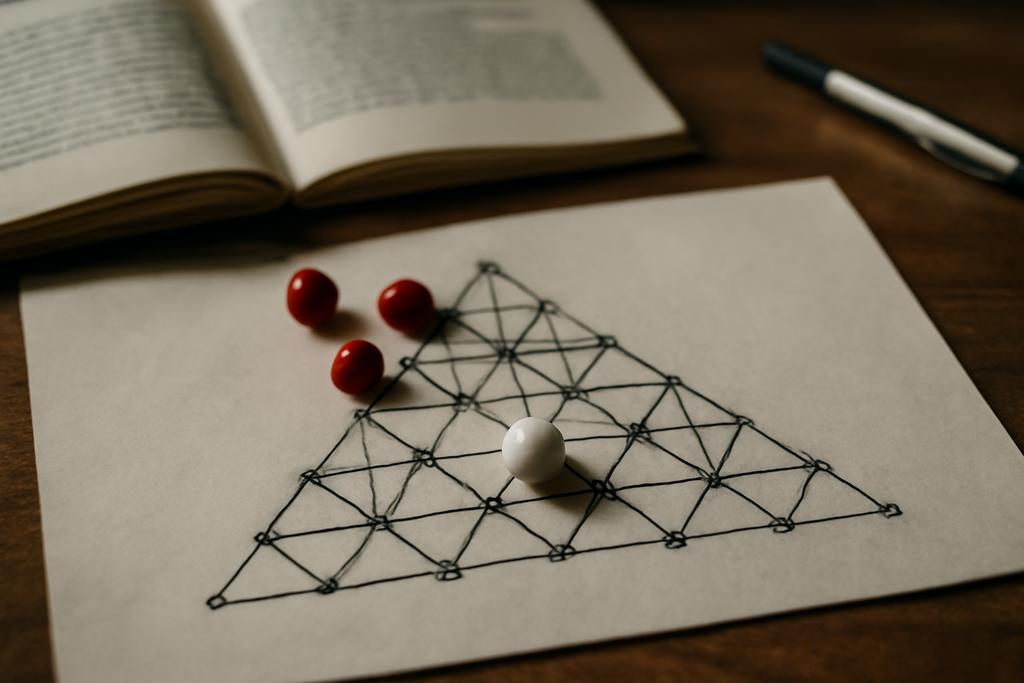The Unexpected Precision of Randomness
Imagine a game of three-dimensional tic-tac-toe, played not with Xs and Os but with particles hopping across a triangular lattice. Each particle can only move if the other two corners of its triangle are empty. This deceptively simple model, studied by researchers at the CUNY Graduate Center and the International Centre for Theoretical Physics, unexpectedly reveals deep truths about the nature of diffusion—the seemingly random spread of particles or information.
The researchers, Adam J. McRoberts, Vadim Oganesyan, and Antonello Scardicchio, didn’t initially set out to solve the mysteries of diffusion. Their focus was on kinetically constrained hopping processes (KCHPs)—models that mimic the frustrating, slow dynamics of glassy materials, those substances that get stuck between liquid and solid states, like window glass or certain polymers. Glasses have puzzled scientists for years; their slow, non-equilibrium behavior is difficult to model. KCHPs offer a simplification, focusing solely on the constraints to particle movement, not the equilibrium state of the system.
The Quantum Trick
But here’s where things get fascinating. The researchers found a clever mathematical trick. They mapped their classical model, with its simple rules for particle hopping, onto a quantum system—specifically, a system of interacting spins. This allowed them to use the tools of quantum mechanics, notably a powerful method called Holstein-Primakoff spin-wave theory, to analyze the system’s behavior.
Why does this quantum leap matter? Because quantum methods can elegantly deal with many-body interactions—the complex interplay between many particles simultaneously. In the world of classical physics, handling such interactions is often a nightmare. It’s like the difference between manually solving a system of linear equations and using a computer program.
The Exact Solution
The results were astonishing. For the triangular lattice and chain KCHP models, the researchers found that a simple approximation—the non-interacting spin-wave theory—produced the *exact* solution for the diffusion constant, a measure of how quickly particles spread. This is incredibly rare in physics, akin to finding an exact solution for a chaotic weather system. Most complex systems require approximations, leading to estimates that are often imprecise.
This unexpected precision isn’t limited to the triangular models alone. The researchers believe it applies to a wide class of KCHPs. The key conditions seem to be (i) hard-core occupancy (particles cannot occupy the same space), (ii) parity symmetry (the system’s behavior is unchanged if the lattice is flipped), and (iii) three-site gates (the movement of a particle is conditioned by the occupancy of two other specific sites). This makes their findings broadly relevant, far beyond the original glass problem they were exploring.
Beyond Triangles: Where Things Get Messy (But Still Interesting)
But the beautiful simplicity of the triangular system doesn’t hold up indefinitely. When the hopping rules are slightly altered to involve four sites (four-site gates), the elegance begins to unravel. The researchers found that these more complex models have corrections to the diffusion constant, requiring more advanced tools, such as Feynman diagrams, for accurate predictions. They even found examples that demonstrate subdiffusion (particles spread *slower* than predicted by standard diffusion equations).
This divergence from the precise predictions of the simpler models is itself valuable. It highlights the delicate balance between order and chaos in such systems. Even small changes to the system’s rules can have dramatic effects on its behavior. The findings suggest a need for greater caution in using simple approximations when dealing with complex, interacting systems in other scientific domains.
Implications Across the Sciences
The implications of this research reach beyond the study of glasses. The techniques developed here—the classical-to-quantum mapping and the application of effective field theory—are broadly applicable. They could offer valuable new tools for modeling the transport of various types of entities in complex systems across numerous fields, from biological transport processes to the movement of information across networks. The simple elegance of the discovery underscores the profound links between seemingly disparate areas of physics and mathematics.
Ultimately, the research reminds us of the enduring power of simple models. Even a game of three-dimensional tic-tac-toe with hopping particles can teach us fundamental lessons about the universe. The work underlines the importance of rigorous mathematical tools and creative thinking in untangling the complexities of nature.










